Peptide Bbeta(15-42) preserves endothelial barrier function in shock
- PMID: 19401765
- PMCID: PMC2670535
- DOI: 10.1371/journal.pone.0005391
Peptide Bbeta(15-42) preserves endothelial barrier function in shock
Erratum in
- PLoS One. 2009;4(6) doi: 10.1371/annotation/9ae032a2-c48d-46d9-9f8f-d3f401714e42
Abstract
Loss of vascular barrier function causes leak of fluid and proteins into tissues, extensive leak leads to shock and death. Barriers are largely formed by endothelial cell-cell contacts built up by VE-cadherin and are under the control of RhoGTPases. Here we show that a natural plasmin digest product of fibrin, peptide Bbeta15-42 (also called FX06), significantly reduces vascular leak and mortality in animal models for Dengue shock syndrome. The ability of Bbeta15-42 to preserve endothelial barriers is confirmed in rats i.v.-injected with LPS. In endothelial cells, Bbeta15-42 prevents thrombin-induced stress fiber formation, myosin light chain phosphorylation and RhoA activation. The molecular key for the protective effect of Bbeta15-42 is the src kinase Fyn, which associates with VE-cadherin-containing junctions. Following exposure to Bbeta15-42 Fyn dissociates from VE-cadherin and associates with p190RhoGAP, a known antagonists of RhoA activation. The role of Fyn in transducing effects of Bbeta15-42 is confirmed in Fyn(-/-) mice, where the peptide is unable to reduce LPS-induced lung edema, whereas in wild type littermates the peptide significantly reduces leak. Our results demonstrate a novel function for Bbeta15-42. Formerly mainly considered as a degradation product occurring after fibrin inactivation, it has now to be considered as a signaling molecule. It stabilizes endothelial barriers and thus could be an attractive adjuvant in the treatment of shock.
Conflict of interest statement
Figures
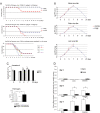
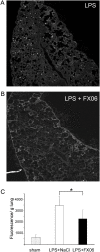
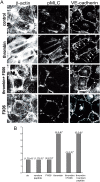
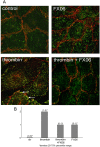
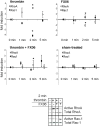
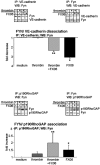

Similar articles
-
Fibrin-VLDL Receptor-Dependent Pathway Promotes Leukocyte Transmigration by Inhibiting Src Kinase Fyn and is a Target for Fibrin β15-42 Peptide.Thromb Haemost. 2019 Nov;119(11):1816-1826. doi: 10.1055/s-0039-1695008. Epub 2019 Aug 29. Thromb Haemost. 2019. PMID: 31466086 Free PMC article.
-
The small fibrinopeptide Bβ15-42 as renoprotective agent preserving the endothelial and vascular integrity in early ischemia reperfusion injury in the mouse kidney.PLoS One. 2014 Jan 2;9(1):e84432. doi: 10.1371/journal.pone.0084432. eCollection 2014. PLoS One. 2014. PMID: 24392138 Free PMC article.
-
The fibrin-derived peptide Bbeta15-42 protects the myocardium against ischemia-reperfusion injury.Nat Med. 2005 Mar;11(3):298-304. doi: 10.1038/nm1198. Epub 2005 Feb 20. Nat Med. 2005. PMID: 15723073
-
FX-06, a fibrin-derived Bbeta15-42 peptide for the potential treatment of reperfusion injury following myocardial infarction.Curr Opin Investig Drugs. 2009 Sep;10(9):997-1003. Curr Opin Investig Drugs. 2009. PMID: 19705343 Review.
-
Dynamic Regulation of Vascular Permeability by Vascular Endothelial Cadherin-Mediated Endothelial Cell-Cell Junctions.J Nippon Med Sch. 2017;84(4):148-159. doi: 10.1272/jnms.84.148. J Nippon Med Sch. 2017. PMID: 28978894 Review.
Cited by
-
Impact of Fibrinogen, Fibrin Thrombi, and Thrombin on Cancer Cell Extravasation Using In Vitro Microvascular Networks.Adv Healthc Mater. 2023 Jul;12(19):e2202984. doi: 10.1002/adhm.202202984. Epub 2023 May 12. Adv Healthc Mater. 2023. PMID: 37119127 Free PMC article.
-
Shear Stress and Endothelial Mechanotransduction in Trauma Patients with Hemorrhagic Shock: Hidden Coagulopathy Pathways and Novel Therapeutic Strategies.Int J Mol Sci. 2023 Dec 15;24(24):17522. doi: 10.3390/ijms242417522. Int J Mol Sci. 2023. PMID: 38139351 Free PMC article. Review.
-
Fibrin-VLDL Receptor-Dependent Pathway Promotes Leukocyte Transmigration by Inhibiting Src Kinase Fyn and is a Target for Fibrin β15-42 Peptide.Thromb Haemost. 2019 Nov;119(11):1816-1826. doi: 10.1055/s-0039-1695008. Epub 2019 Aug 29. Thromb Haemost. 2019. PMID: 31466086 Free PMC article.
-
FX06 to rescue SARS-CoV-2-induced acute respiratory distress syndrome: a randomized clinical trial.Crit Care. 2023 Aug 29;27(1):331. doi: 10.1186/s13054-023-04616-1. Crit Care. 2023. PMID: 37641136 Free PMC article. Clinical Trial.
-
Potential Agents against Plasma Leakage.ISRN Pharmacol. 2011;2011:975048. doi: 10.5402/2011/975048. Epub 2011 Apr 3. ISRN Pharmacol. 2011. PMID: 22084722 Free PMC article.
References
-
- Faust SN, Levin M, Harrison OB, Goldin RD, Lockhart MS, et al. Dysfunction of endothelial protein C activation in severe meningococcal sepsis. N Engl J Med. 2001;345:408–416. - PubMed
-
- Matsuda N, Hattori Y. Vascular biology in sepsis: pathophysiological and therapeutic significance of vascular dysfunction. J Smooth Muscle Res. 2007;43:117–137. - PubMed
-
- Petzelbauer P, Zacharowski PA, Miyazaki Y, Friedl P, Wickenhauser G, et al. The fibrin-derived peptide Bbeta15-42 protects the myocardium against ischemia-reperfusion injury. Nat Med. 2005;11:298–304. - PubMed
-
- Sohn RH, Deming CB, Johns DC, Champion HC, Bian C, et al. Regulation of endothelial thrombomodulin expression by inflammatory cytokines is mediated by activation of nuclear factor-kappa B. Blood. 2005;105:3910–3917. - PubMed
Publication types
MeSH terms
Substances
LinkOut - more resources
Full Text Sources
Other Literature Sources
Miscellaneous

